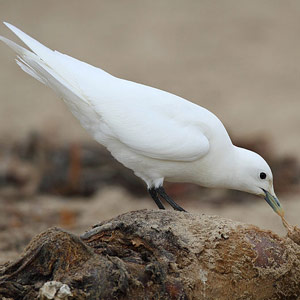Magazine | Études
La Mouette blanche, le Dodo du 21ème siècle ?

Mouette blanche (Pagophila eburnea) se nourrissant sur un cadavre sur une plage de Californie.Photographie : Alan Vernon / Wikimedia Commons
Introduction
La Mouette blanche (Pagophila eburnea) est une espèce marine du Haut-Arctique, très peu connue, qui dépend étroitement de la banquise, et qui est donc gravement menacée par le réchauffement climatique.
Afin de mieux connaître sa biologie, le Groupe Arctique de Recherche en Ecologie (GREA), une association française, étudie depuis 2003 cette espèce le long de la côte orientale du Groenland. En 2007, 13 Mouettes blanches ont été équipées de balises pour suivre leurs déplacements.
Abstract
The Ivory Gull (Pagophila eburnea) breeds right around the northern hemisphere but rarely ventures south of the Arctic Circle, nesting on boulder fields and rocky cliffs inland from the frozen sea and wintering mostly on pack ice. It is an uncommon bird, and it has a patchy distribution around the high Arctic. It is highly threatened by the global warming.
Since 2003, the Arctic Ecology Research Group (GREA), a French based NGO, studies this emblematic and poorly known species in North-eastern Greenland. In 2007, they managed to trap and fit 13 adult gulls with PTT (Platform terminal transmitters) at two colonies. For the entire year that followed, lots of data were transmitted to their computers, providing new surprises and bringing new knowledge about the biology of this endangered and declining species.
Poursuivez la lecture de cet article, en vous abonnant dès maintenant !
Découvrez les Archives d’Ornithomedia.com
Pour seulement 10,00 €TTC/an (ou 6,00 € les 6 mois)
Profitez de plusieurs centaines d’articles en accès illimité et sans aucun engagement.
Compléments
Contacts
Olivier Gilg, Brigitte Sabard et Adrian Aebischer -Missions Ecopolaris – Groupe de Recherche en Ecologie Arctique, 16, rue de Vernot, F-21440 Francheville – E-mail: grearctique@free.fr – Site web: http://grearctique.free.fr.
À lire sur le web
Sur le site web du GREA sont présentés les trajets de certaines plusieurs mouettes équipés de transmetteurs (les cinq mouettes équipées en 2008 portent toutes des balises solaires de 12 grammes) : www.seaturtle.org
Ouvrages recommandés
- Le Guide Ornitho de L. Svensson
- Gulls of Europe Asia and N America de Klaus Malling Olsen
Sources
- Falk, K., Hjort, C., Andreasen, C., Christensen, K.D., Elander, M., Ericson, M., Kampp, K., Kristensen, R.M., Møbjerg, N., Møller, S., & Weslawski, J.M. (1997) Seabirds utilizing the Northeast Water polynya. Journal of Marine Systems, 10, 47-65.
- Gilchrist, G., Strøm, H., Gavrilo, M.V., & Mosbech, A. (2008) International Ivory Gull conservation strategy and action plan. CAFF Technical Report No. 18 Conservation of Arctic Flora and Fauna (CAFF) International Secretariat, Circumpolar Seabird Group (CBird), Akureyri.
- Gilchrist, H.G. & Mallory, M.L. (2005) Declines in abundance and distribution of the ivory gull (Pagophila eburnea) in Arctic Canada. Biological Conservation, 121, 303-309.
- Gilg, O., Hanski, I., & Sittler, B. (2003) Cyclic dynamics in a simple vertebrate predator-prey community. Science, 302, 866-868.
Gilg, O., Sabard, B., Kampp, K., Andreasen, C., Scheifler, R., Ioset, J., Schwoehrer, - C., Druesne, C., Wiest, J.P., Schreiber, M., Geoffroy, L., & Barrat, J.-A. (2005) Ecopolaris Tara 5 expedition to NE Greenland 2004 GREA, Francheville.
- Hjort, C., Hakansson, E., & Stemmerik, L. (1983) Bird observations around the Nordøstvandet polynya, Northeast Greenland, 1980. Dansk Ornithologisk Forenings Tidsskrift, 77, 107-114.
- Sittler, B. (1995) Response of stoat (Mustela erminea) to a fluctuating lemming (Dicrostonyx groenlandicus) population in North East Greenland: preliminary results from a long term study. Annales Zoologi Fennici, 32, 79-92




Aucun commentaire sur ce sujet
Participer à la discussion !